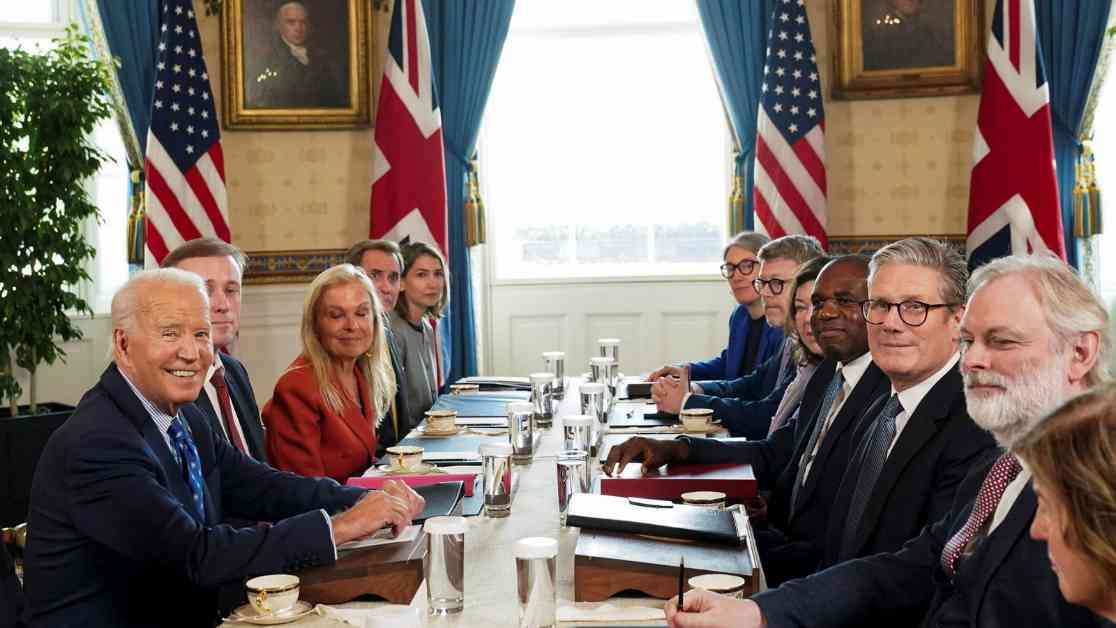The recent meeting between UK Prime Minister Sir Keir Starmer and US President Joe Biden in Washington has sparked discussions about the US-UK relationship and concerns over Ukraine’s use of long-range missiles. The two leaders discussed various issues, including the wars in Ukraine and Gaza, during what was described as a “long and productive” meeting at the White House. While Sir Keir emphasized the strategic alignment between the two countries in addressing the conflicts, questions lingered about Ukraine’s potential use of long-range missiles.
Challenges Surrounding Ukraine’s Long-Range Missiles
As the conflict in Ukraine continues to escalate, Ukrainian President Volodymyr Zelenskyy has been pushing for Western allies, including the UK and the US, to allow his forces to use long-range missiles to strike inside Russian territory. Despite the increasing pressure from Ukraine, Western nations have thus far refrained from approving the use of such missiles, citing concerns about potential escalation in the conflict.
During the meeting between Sir Keir Starmer and President Biden, there were discussions about the possibility of permitting Ukraine to use British Storm Shadow missiles for expanded strikes into Russia. While US officials familiar with the talks indicated that Sir Keir was seeking US approval for this move, President Biden’s consent would be essential as Storm Shadow components are manufactured in the US. However, both leaders avoided providing a definitive decision on the matter during their post-meeting interactions with the media.
The US’s cautious approach to potentially allowing Ukraine to use long-range missiles stems from concerns about the impact such a decision could have on the conflict. While Ukraine already possesses the capability to strike into Russia using drones, the addition of US missiles could enhance this capacity. Nonetheless, US officials have highlighted the limitations and costs associated with deploying these missiles, suggesting that they may not fundamentally alter the overall dynamics of the conflict.
Vladimir Putin’s Warning and NATO’s Response
In response to the discussions surrounding Ukraine’s potential use of long-range missiles, Russian President Vladimir Putin issued a stern warning, stating that permitting such actions would effectively put Moscow “at war” with NATO. Putin emphasized that allowing Ukraine to strike inside Russian territory would significantly alter the nature of the conflict, potentially leading to direct involvement from NATO countries and escalating tensions between Russia and the West.
President Biden downplayed Putin’s threats, expressing little concern about the Russian leader’s remarks. However, the potential repercussions of allowing Ukraine to unleash long-range missiles remain a point of contention within the US and among Western allies. Despite the pressure from Ukraine and the looming threat of further escalation in the conflict, decision-makers are treading cautiously to avoid exacerbating the situation.
The Need for a Coordinated Strategy
As discussions continue about the possibility of permitting Ukraine to use long-range missiles, there is a growing recognition of the need for a coordinated strategy among Western allies. Both the UK and the US are exploring options to support Ukraine while balancing the risks of escalating the conflict with Russia. The strategic discussions between Sir Keir Starmer and President Biden underscore the importance of aligning efforts to address the challenges posed by the ongoing conflicts in Ukraine and beyond.
Moving Forward: Building an Allied Coalition
In light of the complexities surrounding Ukraine’s potential use of long-range missiles, there is a pressing need to build an allied coalition to navigate the evolving dynamics of the conflict. The discussions between the UK and the US represent a starting point for engaging other nations in supporting a coordinated approach to addressing the challenges in Ukraine. By leveraging the special relationship between the UK and the US, efforts are underway to rally support for a strategic shift that aligns with Ukraine’s goals and the broader interests of Western allies.
The Path Ahead: Navigating Uncertainties
As the situation in Ukraine remains fluid and unpredictable, decision-makers are faced with navigating uncertainties on multiple fronts. The political landscape both in Ukraine and among Western nations adds another layer of complexity to the ongoing discussions about long-range missiles and strategic responses to the conflict. With the specter of a potential change in leadership in the US looming, the need for a cohesive and proactive approach to addressing the challenges in Ukraine becomes increasingly paramount.
In Conclusion
The discussions between Sir Keir Starmer and President Biden have shed light on the complexities surrounding Ukraine’s potential use of long-range missiles and the broader implications for the conflict. As Western allies deliberate on the best course of action, the need for a coordinated strategy and a united front in supporting Ukraine’s efforts remains crucial. By navigating the uncertainties and challenges ahead with a strategic mindset, the US-UK relationship can strengthen its resolve to address the conflicts in Ukraine and beyond effectively.













